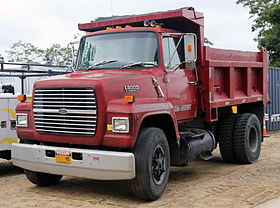Ford L-Series Trucks
| Ford L-Series Trucks | |
|---|---|

1989 Ford LN8000 single-axle dump truck
|
|
| Overview | |
| Type | Medium-duty truck Heavy-duty truck |
| Manufacturer | Ford Motor Company |
| Production | 1970 - 1998 1997-2009 (as Sterling) |
| Assembly | United States: Louisville, Kentucky, (Kentucky Truck Assembly) |
| Body and chassis | |
| Class | Class 6-8 truck |
| Layout | Conventional cab |
| Chronology | |
| Predecessor | Ford N-Series |
| Successor | Sterling Trucks: A-Line, L-Line, Acterra |
The Ford L-Series (also named Ford Louisville or Ford Aeromax) is a range of heavy-duty trucks that were assembled and marketed by Ford between 1970 and 1998. The first dedicated Class 8 truck produced by the company, the L-Series range replaced the N-Series short conventional (derived from the F-Series). Produced as both straight trucks and semitractors, the Ford L-Series encompassed a wide range of models through the Class 7-8 GVWR ratings in medium-duty, severe-service, and vocational applications. The line would become one of the most popular series of trucks Ford ever produced.
The L-Series was produced in the Kentucky Truck Plant near Louisville, Kentucky, which gave rise to the nickname "Louisville Line" trucks; as part of a 1996 redesign, part of the model line officially took on the Louisville nameplate.
Following the sale of the Ford heavy-truck line to Freightliner in 1996, the L-Series was discontinued by Ford at the end of 1998. Freightliner would concurrently take over production of the Ford L-Series, opening its Sterling Trucks subsidiary; the L-Series became the Sterling A-Line, Acterra, and L-Line, remaining in production until 2009 when Sterling Trucks closed operations.
In 1963, Ford produced its first Class 8 conventional with the introduction of the N-Series Super Duty, replacing the Super Duty models of the F-Series. As Ford did with the H-Series cabover (derived from the C-Series), an all-new chassis raised the cab upward; while sharing its grille with the H-Series, the N-Series shared its cab with the F-Series pickup trucks.
By the end of the 1960s, Ford sought to modernize and streamline its heavy-truck line. In 1967, the medium-duty F-Series (F-600 to F-800), becoming a larger, separate model lineifrtr; the same year, the H-Series was replaced by the all-new W-Series cabover. In a change from adapting the F-Series to become a heavy truck, to replace the N-Series, Ford began design work on an all-new truck range, which became the L-Series. With an all-new heavier-duty chassis, the L-Series also featured a larger cab; to improve serviceability, the design included a front-hinged hood.
For 1970, the L-Series was introduced in 4 size ranges, two hood lengths and grille styles, and with single or tandem (denoted by the "T" in the model designation) rear axles. Powertrains included a wide range of gasoline and diesel engines, based on GVWR.
In 1971, Ford introduced a set-back front axle configuration. For the rest of the 1970s, the L-Series saw few major changes. In 1976, the LL/LTL-9000 was introduced. Designed as a truck for long-haul drivers, the LTL-9000 was a competitor to the GMC General, Kenworth W900, Mack Super-Liner, and Peterbilt 359. Fitted with a set-forward front axle and a longer hood, this version had more room for larger powertrains. In 1978, Ford gave the LL/LTL-9000 its own grille and headlight styling, including one of the first uses of the Ford Blue Oval in North America.
...
Wikipedia
